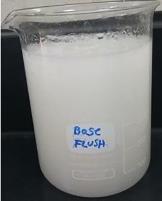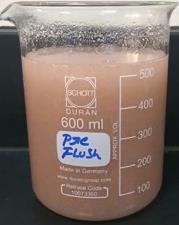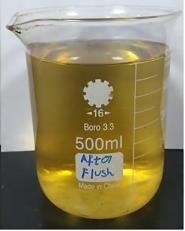GT-B2 Bio-Chem Enzyme
This new product is a combination of bio-enzyme mixed with certain chemicals to extend the enzyme interaction with the formation fluid without any attack to the formation matrix. During production in oil/gas wells, there are certain materials that precipitate and accumulate around the perforation zone and inside the formation close to the well. Well damages are coming from:
Drilling Mud; like mud cake and added chemicals to the drilling mud. There are over 22 different chemicals added to the mud that cause pore plugging and formation damage. -
Scale Build up: Scales are K40+, Ca++, Mg++ and Carbonate. K40+ is radioactive and indicative on the GR as it increases during production. Once combined, these materials build a hard-precipitated mix that plug the perforation completely.
-
Natural Organic Radioactive Materials (NORM): This material is produced naturally with oil and precipitates close to the perforation zone because of the sudden solution gas expansion, causing pores and perforation carrot-hole plug.
Paraffins and Asphaltene: These two materials are produced with oil. They are the most difficult materials causing well plugs. It is not easy to deal with the two materials because it continuously flows during production, accumulate close to the wellbore and inside the well casing and tubing once the solution gas is released or during crude oil cooling. When hard, the two materials totally plug wells, especially when some sand particles are produced as well. The hard solid material inside the well is the most difficult one to remove.
The GT-B2 product is hydrophobic as it does not have active charges and is non-
polar, repelling all contacts with formation water, rather, it interacts with the crude oil heavy components and other materials mixed with oil in the formation. Since crude oil and gas are hydrophobic, this product interacts with the Paraffins and Asphaltene in a proper way to remove them from the damaged zone, clearing the path for the crude oil flow, along with the gas. The product has some mild chemicals (Kerosene and Xylene), which according to the EPA in US is categorized as hazardous materials. Therefore, the product requires careful handling and use in the field.
The GT-B2 enzyme dissolves part of the plugging materials and makes the materials very fragile and easy to break. GT-B2 dissolves the Paraffins, Asphaltene, and NORM of the plug materials inside the well. As for inside the reservoir, these plugging materials will be completely dissolved and later flowed back with production. All the pore zones will be clean as a result.
We use the GT-B2 enzyme after creating the pool zone with GMG, and this will make the enzyme to work better and faster. The enzyme requires time to clean up the formation, we therefore, spot the enzyme inside the pool and keep it for 50-90 hours until it totally dissolves all plugging materials, then flow the solution back.
Hydrophobic materials are used to remove oil from water, manage oil spills, and chemical separation processes that require the removal of non-polar substances from polar compounds. The use of GT-B2 requires that the formation should have low clay content. If the formation has high clay content, then it is recommended that lower concentration of the product be used, despite GT-B2 does not affect the clay by all means. It is also recommended to apply the Diagnosed Fluid Injection Test (DFIT) test on the formation before any implementation of the product.

The DFIT Test:
Diagnostic Fracture Injections Test (DFIT) is a method to determine hydraulic fracture propagation pressure, fracture closure pressure, fracture Process Zone Stress, and near well- bore tortuosity. Most significantly, properly executed and evaluated DFITs can yield valuable analysis of reservoir pressure and permeability in very low permeability reservoirs.
This explanation and definition of the process to conduct the pumping and pressure data acquisition for an effective DFIT. This process outlines proven processes and is considered a minimum standard for pumping and pressure data acquisition of all DFITs. However, we introduce a new product invented by our partner company that avoids the DFIT implementation, it is called Groundbreaking Meteoric Gun (GMG).
The Bio-Enzyme:
Bio-Enzyme can replace acidizing the perforated zones without
interacting or reacting with the matrix. Paraffins are straight or branched chain non-polar alkanes of relatively high molecular weight. This solvent, dispersant, inhibitor, and crystal modifier stimulates the formation and cleans it from any Paraffins precipitation. GT-B2 enzyme becomes continually active dissolving the Paraffins and Asphaltene components after 40 hours inside the reservoir. The amount of the coded GT-B2 required to dissolve and clean the reservoir depends on the following:
- Size of the pool generated by the Groundbreaking Meteoric Gun (GMG). This is estimated based on the GMG size and the length of the gun.
- Origin of the crude oil: whether crude oil is Aromatic or Paraffinic base, the API grade, viscosity of the crude, temperature of the reservoir and reservoir bottom hole static pressure.
- Production of sand and silt.
- An estimated production of NORM.
- Water cut.
- Permeability of the reservoir interval requires cleaning.
- Estimated clay content in the pore and type.
- Formation water TDS and salinity.
- What choke size was set to produce crude oil and for how long.
Pre-Enzyme Operation:
The GT-B2 coded material has exceedingly high concentration of the coded Bio- Chem Enzyme and should NOT be used, touched by personnel at the well site or in the store. Once GTC experts arrive on the location (on in a store), they will prepare the GT- B2 normal product that is used for well stimulation. If there is heavy scaling inside the casing, then certain mixture must be used to clean the perforation interval.
If the perforation interval has lots of scales inside the casing, or directly at the formation face, it is recommended to do the pre-cleaning- in-hole cleaning first;
- A combination of 6.5% hydrochloric acid, 3% acetic acid and 4% enzyme-G(from GTC) to remove sludge and hard scales inside the casing and in front of the perforation interval. This mixture must be placed in front of the perforation zone and keep it for less than 40 minutes before its removal, or simply use jetting at the end of Coiled Tubing (or pipe) and inject it with Nitrogen gas to remove all scales inside the casing.

- The oil and gas wells are cleaned with base fluid, using the composition of 12% Benzoic Acid and some polymer ONLY if the slug is heavy and not easy to remove. A blend of sulfonated is mostly used in gas wells to better control, followed by some light crude oil if available, otherwise, 8 barrels of Kerosene will be sufficient.

- A combination of 7% HCl acid, 5% Acetic Acid and 2% Ammonium Chloride (if available, otherwise, ignore the Chloride), will perfectly remove the heavy sludge inside the casing. This mixture must be left in front of the perforation interval for no more 70 minutes. Surfactant and some inhibitors are recommended to protect the casing and other downhole completion.

|